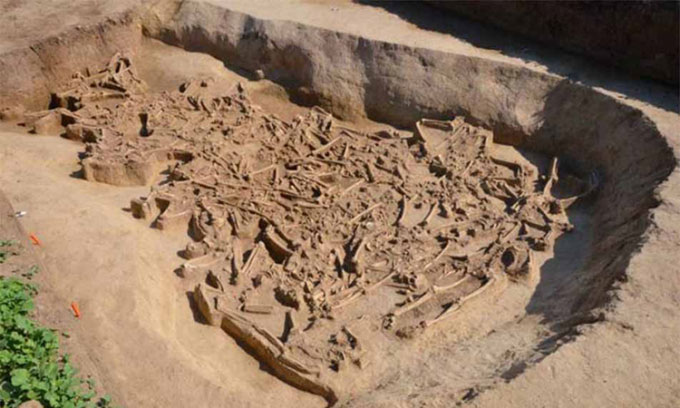The remains, including men, women, and children, show signs of broken bones close to the time of death and are likely victims of sacrificial rituals.
Archaeologists have unearthed a mass grave containing dozens of headless skeletons in a settlement that existed from around 5250 to 4950 BCE in Vrable, western Slovakia, as reported by Ancient Origins on September 28. This site spans 50 hectares and is one of the largest Neolithic settlements ever excavated in Central Europe. The mass grave is the most impressive discovery to date at the Vrable settlement.

Neolithic mass grave in Vrable, western Slovakia. (Photo: Ivan Cheben/Slovak Academy of Sciences/Slovakia Spectator).
A German-Slovak archaeological team has been excavating this settlement for the past seven years. The settlement includes three residential areas, one of which features a defensive ditch and barricades. This particular residential area has six entrances.
During this year’s excavations, the team discovered the mass grave beneath a ditch near one of the six entrances, according to expert Zuzana Hukelová from the Slovak Academy of Sciences (SAS). The grave contains the remains of 35 individuals, possibly victims of ancient sacrificial rituals. They appear to have been thrown in haphazardly, with positions including lying on their backs, on their sides, and face down, with arms and legs spread out.
The remains in the grave include men, women, and children, but it seems that the majority are teenagers and young adults. A child’s skull and a piece of a lower jaw are the only head bones found in the grave, indicating that the heads may have been severed from the bodies.
The remains show clear signs of bone fractures near or at the time of death. In such wounds, there are no signs of healing.
Human sacrifice is one possible explanation for the dozens of headless skeletons in the mass grave. However, experts need to conduct more thorough research to accurately determine the cause of death. They will also investigate whether the individuals in the grave died separately or simultaneously, possibly as victims of disease or ritual sacrifices.
The research team plans to examine whether there is any genetic relationship among the individuals. Additionally, they will investigate how the skulls became separated and whether they decomposed completely in the grave.
The team of experts hopes that these investigations will provide deeper insights into the Neolithic residents of Vrable. “At that point, we may be able to answer some questions about the social classification of the Vrable inhabitants, the emerging social inequalities in early agricultural societies, and perhaps even reconstruct the activities or causes that led to the collapse of this vast settlement,” shared Matej Ruttkay, director of the Archaeological Institute at SAS.


















































